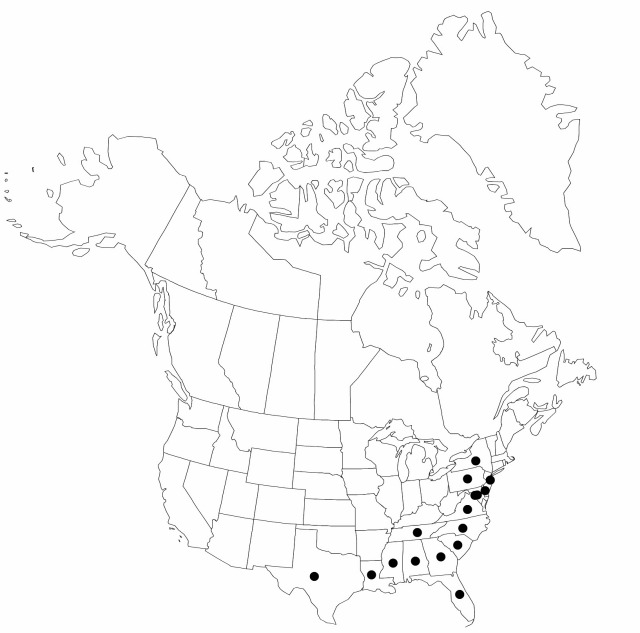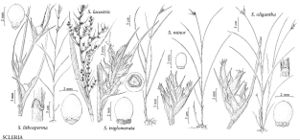Difference between revisions of "Scleria minor"
Pl. S. New Jersey, 283. 1912.
FNA>Volume Importer |
imported>Volume Importer |
||
| (3 intermediate revisions by 2 users not shown) | |||
| Line 6: | Line 6: | ||
|place=283. 1912 | |place=283. 1912 | ||
|year=1912 | |year=1912 | ||
| + | }} | ||
| + | |special_status={{Treatment/ID/Special_status | ||
| + | |code=F | ||
| + | |label=Illustrated | ||
| + | }}{{Treatment/ID/Special_status | ||
| + | |code=E | ||
| + | |label=Endemic | ||
}} | }} | ||
|basionyms={{Treatment/ID/Basionym | |basionyms={{Treatment/ID/Basionym | ||
|name=Scleria triglomerata var. minor | |name=Scleria triglomerata var. minor | ||
|authority=Britton | |authority=Britton | ||
| + | |rank=variety | ||
|publication_title=in N. L. Britton and A. Brown, Ill. Fl. N. U.S. | |publication_title=in N. L. Britton and A. Brown, Ill. Fl. N. U.S. | ||
|publication_place=1: 282. 1896 | |publication_place=1: 282. 1896 | ||
| Line 37: | Line 45: | ||
-->{{#Taxon: | -->{{#Taxon: | ||
name=Scleria minor | name=Scleria minor | ||
| − | |||
|authority=(Britton) W. Stone | |authority=(Britton) W. Stone | ||
|rank=species | |rank=species | ||
| Line 51: | Line 58: | ||
|publication title=Pl. S. New Jersey, | |publication title=Pl. S. New Jersey, | ||
|publication year=1912 | |publication year=1912 | ||
| − | |special status= | + | |special status=Illustrated;Endemic |
| − | |source xml=https:// | + | |source xml=https://bitbucket.org/aafc-mbb/fna-data-curation/src/2e0870ddd59836b60bcf96646a41e87ea5a5943a/coarse_grained_fna_xml/V23/V23_442.xml |
|genus=Scleria | |genus=Scleria | ||
|species=Scleria minor | |species=Scleria minor | ||
Latest revision as of 20:40, 5 November 2020
Plants perennial; rhizomes clustered, nodulose, rather slender, to 3 mm thick, hard. Culms in tufts, usually filiform, very slender, 35–80 cm, base 1–2 mm thick, glabrous or nearly so, somewhat scabrous toward apex. Leaves: sheaths purple tinged, scarcely winged, glabrous or minutely pilose; contra-ligules ovate, quite short, rigid; blades attenuate, keeled, shorter than culms, 1–2.5 mm wide, usually glabrous or nearly so. Inflorescences axillary and terminal, fasciculate; fascicles (1–)2(–3), 10–18 × 4–8 mm, each with 1–5 spikelets, the lateral on long filiform peduncles; bracts subtending inflorescence leaflike, lanceolate, 3–9 cm, long acuminate-attenuate, usually glabrous. Spikelets bisexual and staminate, brown, 3–6 mm; staminate scales lanceolate-acuminate, pistillate scales ovate, midrib excurrent, awnlike. Achenes brownish gray or with dark longitudinal bands, ovoid, 1.5–2 mm, smooth, shining, apex distinctly umbonate; hypogynium somewhat reduced, obscurely 3-angled, low, covered with whitish siliceous, papillose-spiculose crust.
Phenology: Fruiting summer.
Habitat: Wet sandy or peaty soils in pinelands and savannas or boggy areas
Elevation: 0–800 m
Distribution

Ala., Del., D.C., Fla., Ga., La., Md., Miss., N.J., N.Y., N.C., Pa., S.C., Tenn., Tex., Va.
Discussion
Scleria minor is mostly confined to the Atlantic and Gulf coastal plains; inland at higher elevations it is very uncommon and usually found in bogs. Some authors subsume the species under a broadly conceived S. triglomerata (R. K. Godfrey and J. W. Wooten 1979; J. W. Kessler 1987).
Selected References
None.
